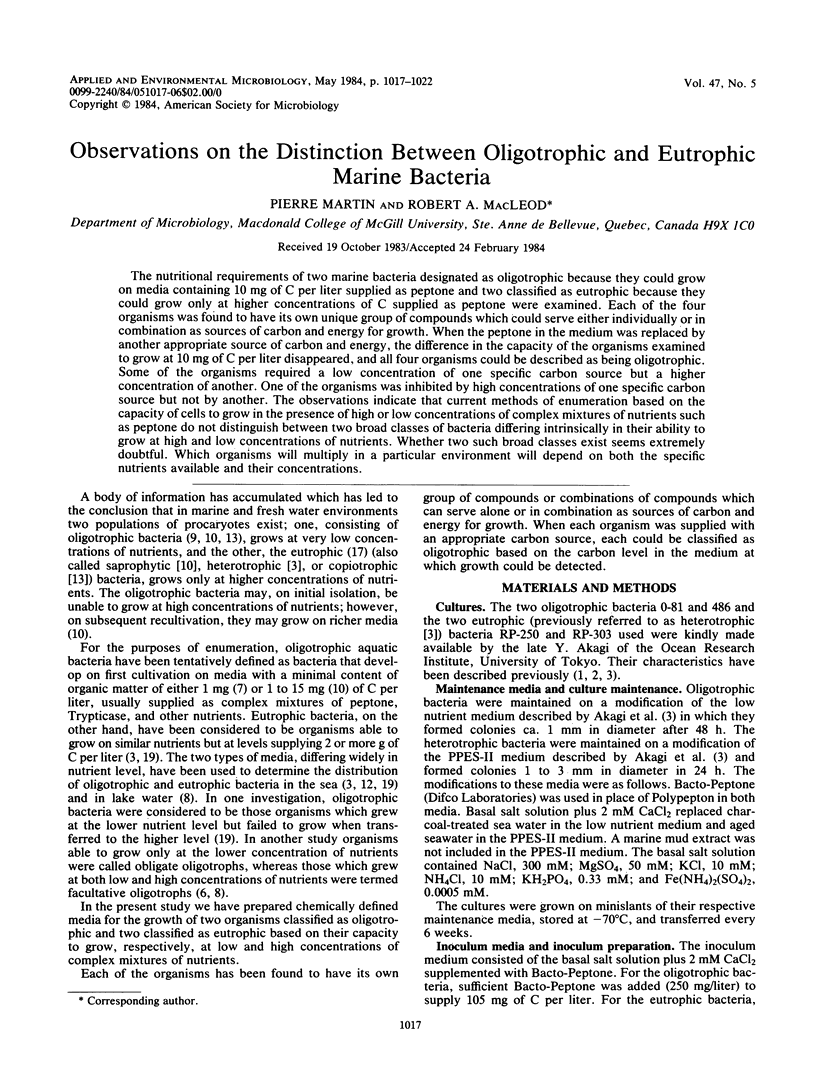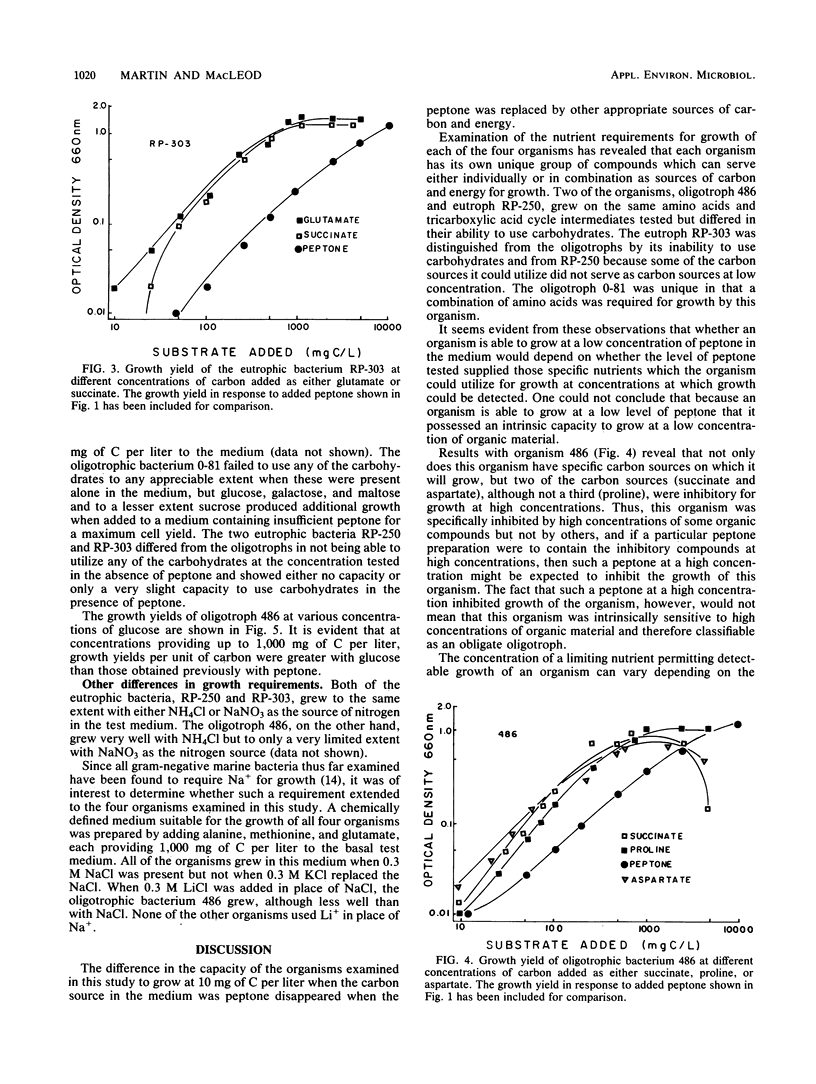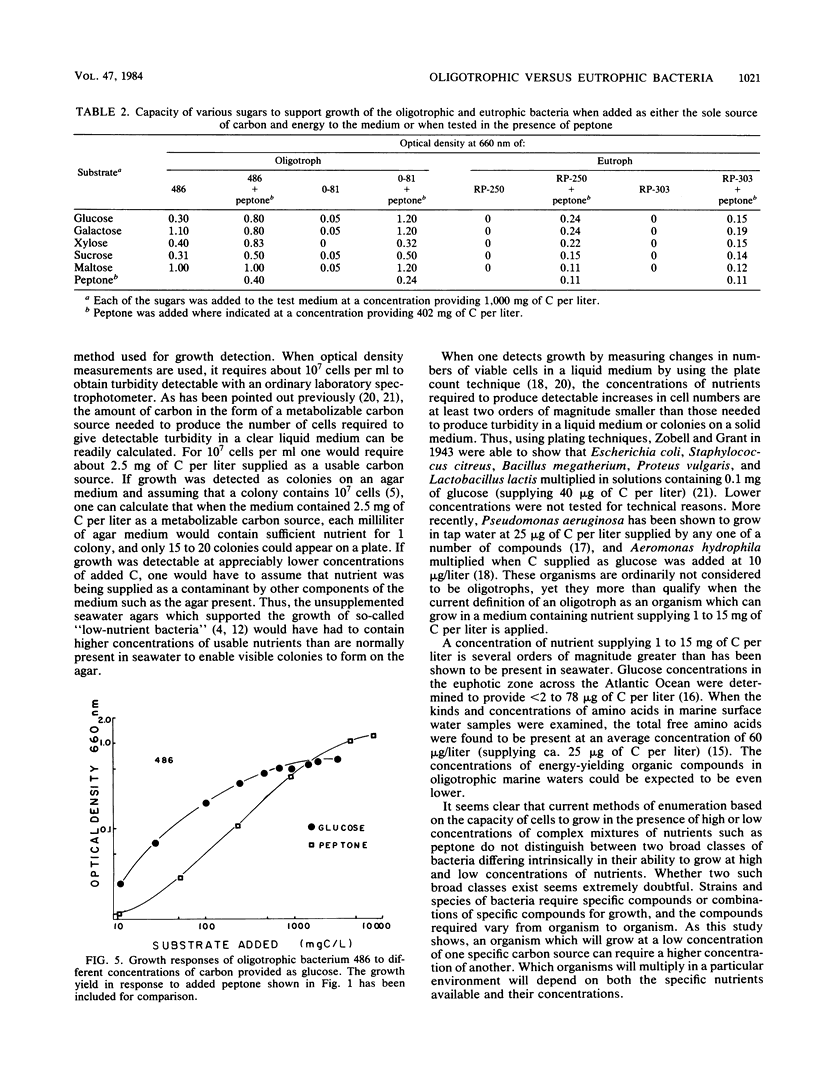Abstract
The nutritional requirements of two marine bacteria designated as oligotrophic because they could grow on media containing 10 mg of C per liter supplied as peptone and two classified as eutrophic because they could grow only at higher concentrations of C supplied as peptone were examined. Each of the four organisms was found to have its own unique group of compounds which could serve either individually or in combination as sources of carbon and energy for growth. When the peptone in the medium was replaced by another appropriate source of carbon and energy, the difference in the capacity of the organisms examined to grow at 10 mg of C per liter disappeared, and all four organisms could be described as being oligotrophic. Some of the organisms required a low concentration of one specific carbon source but a higher concentration of another. One of the organisms was inhibited by high concentrations of one specific carbon source but not by another. The observations indicate that current methods of enumeration based on the capacity of cells to grow in the presence of high or low concentrations of complex mixtures of nutrients such as peptone do not distinguish between two broad classes of bacteria differing intrinsically in their ability to grow at high and low concentrations of nutrients. Whether two such broad classes exist seems extremely doubtful. Which organisms will multiply in a particular environment will depend on both the specific nutrients available and their concentrations.
Full text
PDF





Selected References
These references are in PubMed. This may not be the complete list of references from this article.
- Akagi Y., Taga N. Uptake of D-glucose and L-proline by oligotrophic and heterotrophic marine bacteria. Can J Microbiol. 1980 Apr;26(4):454–459. doi: 10.1139/m80-075. [DOI] [PubMed] [Google Scholar]
- Aragi Y., Taga N., Simidu U. Isolation and distribution of oligotrophic marine bacteria. Can J Microbiol. 1977 Aug;23(8):981–987. doi: 10.1139/m77-146. [DOI] [PubMed] [Google Scholar]
- Kuznetsov S. I., Dubinina G. A., Lapteva N. A. Biology of oligotrophic bacteria. Annu Rev Microbiol. 1979;33:377–387. doi: 10.1146/annurev.mi.33.100179.002113. [DOI] [PubMed] [Google Scholar]
- Mallory L. M., Austin B., Colwell R. R. Numerical taxonomy and ecology of oligotrophic bacteria isolated from the estuarine environment. Can J Microbiol. 1977 Jun;23(6):733–750. doi: 10.1139/m77-110. [DOI] [PubMed] [Google Scholar]
- Reichelt J. L., Baumann P. Effect of sodium chloride on growth of heterotrophic marine bacteria. Arch Microbiol. 1974 May 20;97(4):329–345. doi: 10.1007/BF00403071. [DOI] [PubMed] [Google Scholar]
- Siegel A., Degens E. T. Concentration of dissolved amino acids from saline waters by ligand-exchange chromatography. Science. 1966 Mar 4;151(3714):1098–1101. doi: 10.1126/science.151.3714.1098. [DOI] [PubMed] [Google Scholar]
- Zobell C. E., Grant C. W. BACTERIAL ACTIVITY IN DILUTE NUTRIENT SOLUTIONS. Science. 1942 Aug 21;96(2486):189–189. doi: 10.1126/science.96.2486.189. [DOI] [PubMed] [Google Scholar]
- Zobell C. E., Grant C. W. Bacterial Utilization of Low Concentrations of Organic Matter. J Bacteriol. 1943 Jun;45(6):555–564. doi: 10.1128/jb.45.6.555-564.1943. [DOI] [PMC free article] [PubMed] [Google Scholar]
- van der Kooij D., Oranje J. P., Hijnen W. A. Growth of Pseudomonas aeruginosa in tap water in relation to utilization of substrates at concentrations of a few micrograms per liter. Appl Environ Microbiol. 1982 Nov;44(5):1086–1095. doi: 10.1128/aem.44.5.1086-1095.1982. [DOI] [PMC free article] [PubMed] [Google Scholar]
- van der Kooij D., Visser A., Hijnen W. A. Growth of Aeromonas hydrophila at Low Concentrations of Substrates Added to Tap Water. Appl Environ Microbiol. 1980 Jun;39(6):1198–1204. doi: 10.1128/aem.39.6.1198-1204.1980. [DOI] [PMC free article] [PubMed] [Google Scholar]


